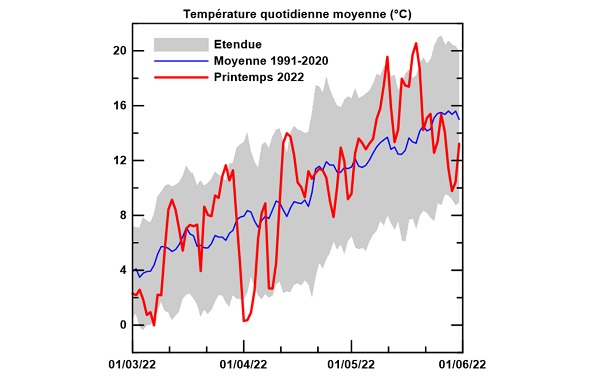 Spring 2022 mean daily temperature in Clemency (red) compared to the reference period 1991-2020 (blue). The range is defined by the average of the minima and maxima of the mean daily temperature (in grey).;
Credit: AgriMeteo / ASTA
Spring 2022 mean daily temperature in Clemency (red) compared to the reference period 1991-2020 (blue). The range is defined by the average of the minima and maxima of the mean daily temperature (in grey).;
Credit: AgriMeteo / ASTA
As spring 2022 draws to a close, AgriMeteo, the national meteorological service of the ASTA (Administration des services techniques de l'agriculture) of Luxembourg's Ministry of Agriculture, Viticulture and Rural Development, has published its weather analysis for the period from 1 March to 31 May 2022.
The analysis looked at the network of 36 automatic weather stations across the Grand Duchy. The three-month values of four representative stations, i.e. Asselborn (north), Clemency (south-west), Remich (Moselle) and Luxembourg City (centre), were compared with the averages of the reference period 1991-2020.
March: high temperatures and rain deficit
The month of March posted warmer temperatures than those of the reference period, with a maximum difference of +1.0°C in Asselborn. In terms of rainfall, March 2022 was too dry throughout the country, with a maximum rainfall deficit of 36 mm in Clemency.
April: too cold, too dry
On the other hand, with temperatures between 7.5°C and 9.6°C, the month of April was colder than the reference average for the whole of the Grand Duchy. Weather stations continued to record a rain deficit in almost the whole country, except in Remich.
May: too hot and too dry
May 2022 was too hot, with temperatures between 13.3°C and 16.0°C. Despite stormy rains which proved beneficial for agriculture, the month of May remained marked by drought.
Agricultural crops have been marked by the lack of rainfall. Winter barley and rapeseed suffered little damage from the drought, while winter wheat suffered. According to AgriMeteo, this damage can still be compensated if it rains enough in the next few weeks. The corn crop benefited from the heat of May, but the summer cereals were badly damaged by the drought.
As for fruit growing, the late frosts in early April caused limited damage, particularly to pear trees in bloom. Sowing and planting of vegetable crops started in March and April at the cost of continuous and costly irrigation. As for the vines, the spring drought slowed the development of cryptogamic diseases, including mildew, black rot and parasitic red mullet. Only the young vines begin to suffer from the lack of water and will require irrigation.








